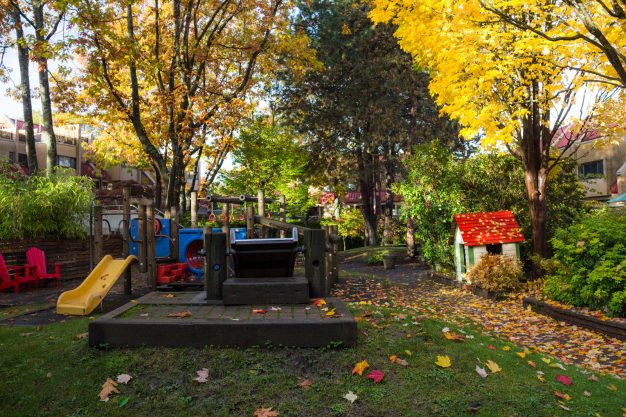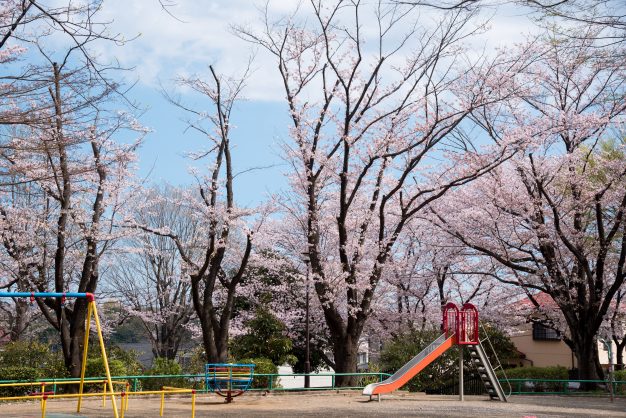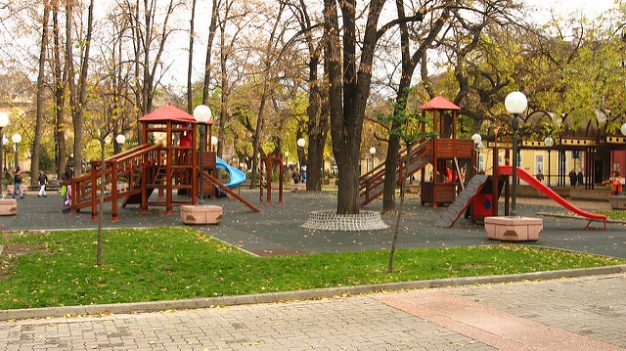
How nature can help promote higher use of play environments
By integrating the living landscape with the built environment, studies show that children reach a higher range of active behaviors, a greater diversity of play opportunities is offered, and the experience becomes more enriching for both children and families.
In this article Ann-Marie Spencer explains why incorporating nature into the built environment can help promote higher uses of play environments.
Changes
When I was a child growing up near Seattle, the best time of the day was when I could go out to play at our local “playground,” aka, the woods behind my house. My friends and I revelled in discovering animal dens, climbing trees to see if there were eggs in the many bird nests, and for one glorious year, playing on a see-saw created when one huge Douglas Fir fell over the remains of another and created a fulcrum that took us 15 feet into the air. You needed about 8 kids per side to get it to move, but it was amazing (until the lot owner cut it up for firewood the next summer). We would play long after the sun had begun to set, the air had chilled, and our skin had taken on the pink flush of kids engaged outdoors. It would take 2-3 times for our parents to successfully call us in for the night. The space was pure magic.
However, about a decade ago, when I had the honor of being a chaperone on a field trip to the woods, I was amazed at the children’s lack of appreciation, and their unfamiliarity with how to play there. While I imagined them engaging in the way I had as a child, what I actually heard was calls of “This is dumb, there’s nothing to do here! How much longer do we have to stay?” We were so shocked, and despite several attempts to engage them, we eventually took them to a local playground and let them finish the afternoon there. I noted to one of the other chaperones, “The way they are playing now, is how we used to play anywhere.” Some of the kids were playing a game of “spaceship,” and using various parts of the playground equipment to represent parts of the ship, the planet surface, and the “shuttle” to transport them between the two. “Why don’t they play like this in the woods?” the other adult asked. Truly, I didn’t know how to respond.
Playgrounds and nature
To help in this regard, the standard playground model of manufactured equipment only is being reconsidered to include a greater diversity of play opportunities in a given setting. By integrating the living landscape with the built environment, studies show that children reach a higher range of active behaviors, a greater diversity of play opportunities is offered, and the experience becomes more enriching for both children and families. This type of environment also helps to reintroduce children to the wonders of nature, while providing the familiarity of play experiences they know.
When building playgrounds in areas with no natural elements, children and families lose the opportunity to engage with the sound of leaves blowing in the breeze, and of birdsong. The shade that is produced by trees offers natural shelter from the sun, while native grasses, plants, and shrubs can create mazes, borders, and can complement the site with fragrant flowers and general beauty. However, in natural settings alone, it is usually the children of nature loving families that know how to play and be engaged, while urban children, or those desensitized to nature by the draw of electronic pastimes, may have little idea what to do. By incorporating these two elements, a naturalized playground can support outdoor play in nature by offering familiar play elements in a natural setting that helps children and families value the beauty and function in ways they cannot in nature settings alone.

Rather than cut down trees to make room for playground equipment, trees should be evaluated by an arborist for their health, and then preserved to create the “anchor” for the site. There is no reason that equipment cannot be sited to take advantage of and to complement existing trees and natural elements, but all too often the site is cleared of all natural elements, creating a very sterile setting. In addition, child-friendly plants should be included, to provide sensory stimulation through contrasting texture and color, interest through seasonal changes, loose parts like cones and sticks that can be used in playful imaginative ways, fragrance, and auditory stimulation. Plants can also be used to enclose the space, direct traffic flow, offer shade and movement and provide an all over identity to the space.
Guidelines on designing play environments
To support this, a book called NatureGrounds, Putting Nature into Play™ provides guidelines on designing play environments that integrate manufactured play equipment with the living landscape. The Natural Learning Initiative, College of Design, NC State University has a great deal of research dealing with exactly why kids react the way they sometimes do to nature environments. Their many studies in and around North Carolina and California show that children enjoy a mix of permanent anchored play structures, open areas, and natural settings, and that spaces created with this in mind will help them get to higher use while at play. To learn more about their background research, go to www.naturegrounds.org.
In addition, these settings can often be more comfortable for adults and caregivers, which may contribute to longer visits, and therefore more healthy, beneficial playtime for children. The sites designed in this manner add visual interest, comfort, a relaxed and playful social atmosphere, and growth of community capital. Furthermore, integrating built and natural environments extends the range of playful opportunities, and options for social, physical, and cognitive behaviors across all stages of development, learning styles, and cultures.
The NatureGrounds book highlights a variety of case study examples that help to prove the model’s usefulness. Kids Together Park in Cary, NC is a universally designed facility of almost two acres with a variety of innovative settings for play. There are three settings that feature playground equipment, including a wheelchair accessible ramped unit. In addition, there is a swing area with trees and plantings that uniquely surround it to create a magical discovery and its own little environment. A dragon sculpture and sand and water play area round out the equipment, which is all joined together by curving pathways that feature natural elements, seating, and artwork along the way. In a behavior mapping study, it was clear that the built environment was by far the most heavily used, but the primary path, grassy areas, and gathering spaces followed closely, showing that a well-designed space will help draw families to all areas, both built and natural, creating more opportunities for meaningful play and socialization.

The built and living landscape
Another space that utilized the NatureGrounds model, listed on naturegrounds.org as a Demonstration Site, is the Stay & Play Hideaway playground at Lake Winnepesaukah, a family-owned amusement park in northern Georgia. While the park features a wealth of rides, games, and events for the entire family, the facility owners wanted a space where “families were able to play on their own schedule without waiting in a line like with all of the rides and concessions.” The large naturalized, playground provides a place to relax and enjoy the shade, while the universally designed play structure offers a play environment that is situated among the many historic trees, making nature integral to the play experience. The natural color palette of the equipment, its close proximity to an existing stream, shade trees, and ample social areas, create the perfect setting where families can gather, recoup, and enjoy an exciting play experience together in nature.
The addition of this playground has increased traffic to the park and expanded the available activities and programs for people of all ages and abilities. While it preserves required safety zones, the manufactured playground equipment was designed to be located in and around the selection of large, mature trees. The trees were evaluated by an arborist to ensure their health, and they were preserved as site assets, offering shade and aesthetic quality. The resulting play space offers a multigenerational, inclusive environment that brings families together, which was designed to promote physical activity and active play settings, maximize active, social, and sensory play opportunities along a developmental continuum, promote sun protection, socio-dramatic play settings, and social gathering areas. The space is also used for community special events and additional programming efforts.
By promoting best practice design principles such as those demonstrated at the aforementioned sites, we can provide exciting, vibrant recreation spaces that integrate the built and living landscape. Plants need not be limited to outer borders and peripheral locations but can be wholly incorporated into the environment through planting pockets and by following simple guidelines for integration that are mindful of use zones and sight lines. By utilizing planting principles designed for long-term success, then being mindful of project sustainability, management, and maintenance, we can help ensure that these dynamic play spaces can benefit children, engage communities, and help promote the importance of the outdoor plan in nature for years to come.
To receive a copy of NatureGrounds, please send an e-mail to aspencer@playcore.com. To learn about research studies, additional sites that have integrated the built and living landscape, or to review a plant database that lists plants by zonal requirements as well as by play value, go to www.naturegrounds.org.
Courtesy of Playground Professionals (PGP)





Plenty of sound stuff about playground design here using the natural environment. But I would never design a playground without some mounding and natural surfacing – grass, sand, woodchip etc. I realise that some countries are over-anxious about legal action, but my experience is that the more interesting detail a playground offers children the less they are likely to get bored and begin to engage in activities outside their safety range.